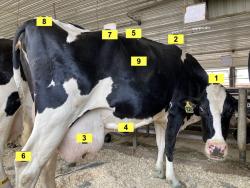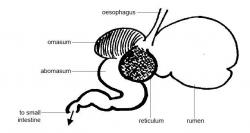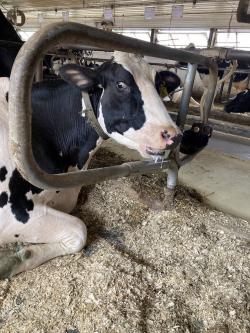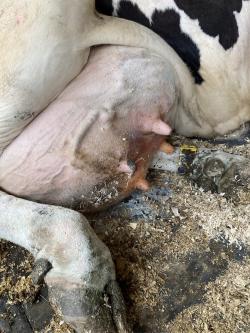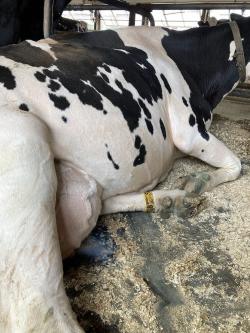For my own personal use only:
- Unique bovine anatomy to keep in mind (see image, right):
- Poll (1): just caudal to the ears, overlying first cervical vertebra
- Withers (2): bony “lump,” caudal aspect of mane; comprised of dorsal spinous processes of thoracic vertebrae
- Mammary gland (3) or udder: highly developed in milk breeds; smaller in beef breeds
- Mammary vein (4): large “subcutaneous abdominal vein” - drains large volume of blood away from mammary gland
- Very large and close to skin surface!
- Do NOT use mammary vein for venipuncture - complications (e.g., thrombophlebitis) may send a dairy cow to slaughter
- Short ribs (5): transverse processes of the lumbar vertebrae (note: they are NOT ribs)
- Hocks (6): tarsus (hind limb)
- Hooks (7): tuber coxae of ilium of pelvis
- Part of pelvis that protrude furthest lateral when view cow from behind
- Pins (8): tuber ischii of ischium of pelvis
- Part of pelvis that protrudes furthest dorsal when view cow from behind
- Paralumbar fossa (9): space on right and left caudal abdomen bounded by last rib cranially, short ribs dorsally, fold of flank caudo-ventrally
- Auscultate digestive organs here
- Unique bovine GI physiology and related management
- Cows are ruminants, or foregut fermenters
- Four compartments of ruminant stomach, each with its own unique digestive function: rumen, reticulum, omasum, and abomasum
- Rumen: large (~40-gallon!) fermentation vat
- Here microbes break down plant material into volatile fatty acids (VFAs)
- Cow absorbs these VFAs to turn into fuel
- Reticulum: receives small batches of fermented feed from rumen to send down the digestive tract
- Heavy ingested particles accumulate here because it is the most ventral compartment
- Most cows have magnets in the reticulum to bind metal objects
- Prevent objects from causing damage (i.e., “hardware disease” or traumatic reticuloperitonitis)
- Administer to cow at < 1 year of age
- Omasum: has many folds of mucosa to absorb water from ingesta
- Abomasum: true, glandular stomach
- Acidic pH
- Digestive functions typical of carnivores and omnivores
- Unique bovine mammary gland physiology: dairy cows are athletes in their own way
- Average Holstein produces about 80 lbs/milk/day (= 10 gallons of milk!)
- We select cattle breeds for milk production (e.g., Holstein, Jersey, and Brown Swiss) that have well-developed mammary glands; producing far more milk than offspring need
- Milk cows for ~300 days per year
- Usually milk cows 2-3 times per day
- “Days in milk” refers to how many days a cow has been lactating
- Cows have a “dry period” of about 60 days prior to delivering their next calf
- We do not milk them during this time
- Udder has a chance to heal/rest and prepare for next lactation
- Cow can devote all her energy stores to the last trimester of gestation
- Reproduction: milk production requires reproduction!
- Breed most dairy breeds for the first time at 12 -13 months of age
- 9-month gestation period
- First 30 days after calving is called the “fresh period”: time of elevated disease risk
- Usually rebreed cows at 60-90 days in milk
- Ideally, cows give birth and start a new lactation once per year
- Unique bovine musculoskeletal anatomy and physiology: lameness is an important welfare concern in cattle
- Distal limb has just two digits
- More weight-bearing on front limbs than hind limbs
- Cows typically lay down for 12-14 hours per day to ruminate and rest their limbs
- Sole of the foot contains a thick fat pad
- Helps with cushioning when standing
- Decreased body condition can remove this fat store, thus increasing lameness
- Typically trim hooves once or twice per year on commercial dairy farms
- Beef cattle that live outdoors are more likely wear their hooves down naturally, depending on terrain
Images courtesy of Liz Brock, DVM, MS except for anatomical specimen (Museum of Veterinary Anatomy FMVZ USP, amended by Liz Brock, DVM, MS) and the forestomachs diagram (Sunshineconnelly).
Top Topic Category
Ruminants
